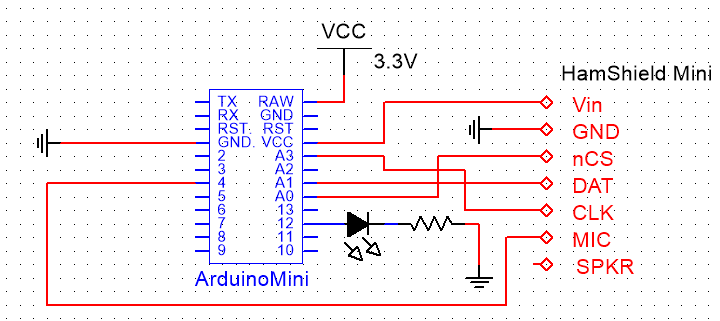DTMF Remote Control with Hamshield Mini

Please press 1 for more options
Introduction
Here again with a great use of the Hamshield Mini. Touch Tone or DTMF are those little beeps you hear when you press the keypad during a phone call. Also, on HTs when you hold transmit, you can create these tones using your keypad. This is primarily used for offsite repeater configuration, or using a phone patch to order a pizza on a repeater. The Hamshield (mini) can send and receive these DTMF codes, so I rigged up a little robotics-like receiver with the arduino.
Setup
As usual, setup your hamshield/hamshield mini as you normally would. Because the hamshield mini doesn’t act as a true daughter board to anything, I used an arduino pro mini and customized my pins. As a baseline test, I only had my receiver control an LED, but you can go nuts on this process. So I also connected a resistor and LED from digital pin 12 to ground. I should note I’m using the 3V3, 8Hz version.

Hamshield Mini Schematic
Now for the code. Once again, it’s very basic. I took the Hamshield Github example and stuck a for loop, waiting to hear the tone “1.” You can find it here on my github, but I put the important code below.
#define OUTPUT_PIN 12
#define MIC_PIN 3
#define RESET_PIN A3
//#define SWITCH_PIN 2
HamShield radio(A0, A3, A1); // nCS, CLK, DAT
uint16_t code = radio.getDTMFCode();
if (code == 1) {
digitalWrite(OUTPUT_PIN, HIGH);
Serial.print("It works!");
delay(1000);
digitalWrite(OUTPUT_PIN, LOW);
}
The result is a flashing LED.
In action (sorry for poor quality)
https://www.youtube.com/watch?v=EavahRFl3rs
Watch the LED at the center.
Applications, Significance, and Further Research
Robots with ham radio. Need I say more? Probably.
The most visible application I can see is on a weather balloon. The HAB crew would have HTs with them, so they could easily make commands while the balloon is mid-flight or or mid-tree. I imagine a servo could replace the LED, and it could drop the load from the chute if its going into the ocean or stuck much too high in a tree.
Because the hamshield is arduino-controlled, you can do almost anything with its pins. The largest problem we encountered was memory - on some scripts (like KISS, more to follow), we easily hit the 75% random memory allocation, causing some setbacks and worry. But clearly the benefits outweigh the cost.
There can be some security concerns with dropping your HAB load on a 2m frequency with just 1 button. I will probably nest the “for” loops and make it a password with 4-5 keypresses.
What applications do you think would work? Have you seen other applications of the Hamshield? Let me know!